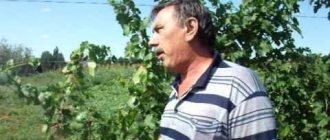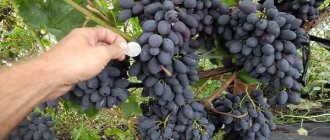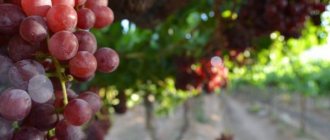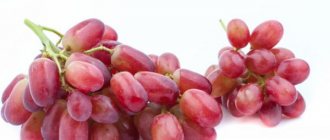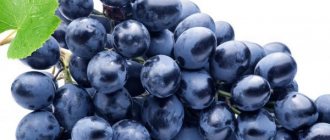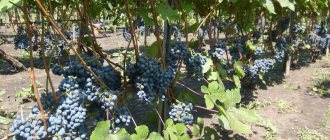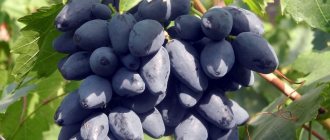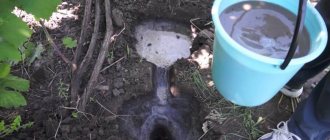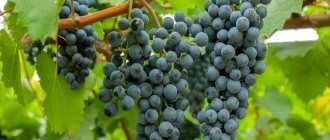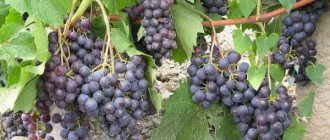Planting and care
Crystal, like most technical varieties, takes root well. To do this, just fulfill a few simple conditions
High-quality planting material
You should buy planting material only in specialized stores and nurseries, which gives an almost complete guarantee of obtaining seedlings of the desired variety.
When choosing seedlings, preference should be given to those grown in nurseries located in the same natural conditions or to the north of the planting site. In this case, plants tolerate acclimatization faster and easier.
When choosing planting material, the main attention is paid to the condition of the root system. It is worth purchasing plants with 2-3 roots, 10 cm long and up to 5 mm thick.
If the root system is open, be sure to inspect the roots. They should not be damaged, the surface should be smooth and brownish-green in color.
Of course, the best option is seedlings with a closed root system, which allows planting to be done safely for the plant.
In this case, it is unfortunately impossible to check the root system. Accordingly, the reputation of the seller plays an important role in the choice.
Correct planting dates
Planting in autumn or spring is allowed, depending on the region. Placement
It is recommended to plant Crystal in a place open to sunlight. The best option is the southern or southwestern slope of the hill, closer to the middle. This will protect the seedlings from cold drafts; if this is not possible, you should build or use a ready-made artificial barrier.
Expert opinion
Olga Nikolaevna Gritsenko
summer resident from Moscow, author of four books on gardening
It is not recommended to plant this variety in lowlands - the retention of cold melt water in the spring and high humidity during summer rains can provoke diseases of the bushes. It is equally important to control the remoteness of water horizons - the groundwater level should be no closer than 1.5 m to the surface.
Preparation
Planting holes are made with a depth of 0.8-1 m. They put in it:
- drainage layer - crushed stone, gravel, pebble about 5-6 cm thick;
- fertile substrate - 3 layers (15-20 cm each) of chernozem or soil with turf, between which superphosphate and potassium sulfate are added
The finished hole is watered abundantly (up to 60 l) and covered. Planting is carried out only at a soil temperature of 10-12, and an air temperature of at least 15ºС (within a week or a decade).
Caring for bushes includes timely watering, fertilization, treatment against diseases and pest control. Although the variety is unpretentious (like most technical ones), you should not neglect at least basic measures.
Climate, growing region
Crystal grapes perform well in regions with temperate climates and warmer zones. In 2002, registered as recommended for the North Caucasus and Lower Volga.
In addition to them, it is distributed in Russia over a vast territory - from the lower Don region and central regions, to some regions of Siberia and the steppes of the Southern Urals.
Recommended for cultivation throughout the Republic of Belarus, it is included in the list of varieties cultivated by Ukrainian and Moldavian winegrowers.
Its high frost resistance allows it to be left on high trunks in most areas, even those that do not belong to traditional viticulture zones. Shelter will only be required at cold temperatures below -30ºС.
The soil
The crystal is unpretentious to soil composition. The most important requirement is their moisture - on dry and waterlogged soils it will not be possible to achieve proper development of bushes, yield and quality of berries.
Nevertheless, care should be taken to concentrate the necessary nutrients during the preparation of the hole for planting and subsequent feeding of the bush.
Features of cultivation
Crystal grapes are very unpretentious to most growing conditions. The variety easily “forgives” beginners even serious mistakes when caring, but the quality and volume of the harvest naturally decreases.
The recommended planting pattern is 3 x 0.5 (0.7) m. The optimal height of the trunk is 1 m (95-105 cm), molding is cup-shaped, heart-shaped, zigzag. For a covering form, a good option is a fan form, which makes it easier to remove from the trellis and insulate the bush on the ground or in a trench.
Signal fruiting begins in the 2nd year after planting, commercial fruiting - in the 4th.
Planting and Harvest Time
When the berries ripen in 110-115 days, the harvest can be harvested in most regions in mid-to-late August.
On private plots, amateur winegrowers often leave the brushes on the bushes for 1-2 weeks to achieve a sweeter taste. As a rule, this is done if the grapes are not used for wine production.
Seedlings are planted:
- At the end of September (in the southern regions). In this case, the time reserve (2-2.5 months before frost) is enough for the plant to take root and adapt to the conditions.
- In the spring, after the air has warmed up to a temperature of 15ºC (if it has not dropped below during the week) and the soil to 12ºC. A simpler option for determining the timing of planting lignified seedlings is April-early May, green seedlings - late May-June.
Features of cultivation
Industrial grape varieties, such as crystal, are much easier to cultivate than table grape varieties.
Landing
Important! When purchasing seedlings, it is important to pay attention to their health. Inspect the root system. It must be strong and undamaged.
Planting is done both in spring and autumn. The night before planting, the seedlings are soaked in water, and the tips of the roots are trimmed in the morning.
Planting process:
- Dig a hole 80x80x80.
- Place a drainage layer on the bottom of the recess.
- Place up to 20 cm of organic fertilizer (manure or humus).
- It is advisable to make a trench for irrigation so that one end is at the roots and the other comes out of the hole.
- Spread the roots of the seedling, place it in a hole and cover it with soil.
- Water the seedling generously with water.
When planting a “crystal”, you must immediately install a support for the bush. This will help the harmonious formation of a fast-growing vine.
For grapes, a sunny and wind-protected place on the site is suitable. It is advisable that this be the south side of the garden. Low-lying and shaded areas are not suitable. More details about the ideal place for grapes in a separate article.
“Crystal” is not picky about the soil. The main thing is not to let it dry out.
For good air exchange, it is necessary to regularly remove weeds and loosen the soil around the bush.
Watering and fertilizing
Young plants under 2 years of age must be watered frequently and abundantly. Adult plants are watered no more than 4 times per season. Most of all, grapes need moisture during the period of leaf blossoming and during the formation of fruits, about a month before the expected ripening of the berries.
Important! Watering must be stopped a week before flowering. Otherwise, the buds may fall off, and the ripening of the crop will be greatly slowed down.
In the fall, when the leaves fall and pruning is done, moisture-charging watering is carried out. It is necessary so that the bushes can begin their development normally in the spring.
The best methods for watering crops are by drip or by using drainage pipes dug into the ground. Grapes react very negatively to wet leaves and after rain they become more vulnerable to fungal diseases.
To protect the vine from unwanted precipitation, it is recommended to install a protective canopy. Or carry out preventive measures - treat the vineyard with fungicides.
If fertilizers were applied during planting of seedlings, then the grapes do not need additional feeding for several years.
Adult crystal plants are fed twice per season:
- In spring, nitrogen-containing fertilizers.
- In autumn, with compounds containing phosphorus and potassium.
You can also buy complex fertilizers in gardening stores and spray the bushes with the solution, following the instructions.
Trimming
In order for the grapes to bear fruit abundantly and have a neat appearance, it is necessary to carry out decorative and sanitary pruning twice a year. If the green mass grows greatly, many of the ovaries will fall off, the berries will become small and lose their taste. The plant will devote all its energy to developing shoots and leaves.
It is very important to monitor the load on the vine. For an adult “crystal” it is no more than 60-65 eyes.
In the spring, shoots that are broken and frozen over the winter are pruned. Fast-growing young shoots are pruned when they reach a length of 2-3 cm. Pruning is carried out again when their length reaches 12-15 cm. Branches that have grown to 60-70 cm are tied to a trellis.
In summer, be sure to monitor the density of the bush and trim the stepsons. When the length of the top is about 170 cm, it needs to be pinned.
In autumn, 2 weeks after the leaves fall, the main pruning is carried out.
Important! So that the air temperature at this time does not drop below -3°C. In the cold, the vine becomes brittle and easy to break.
On young seedlings, 4-8 well-developed strong shoots are left, shortening them above 4-5 buds. Adult plants are completely cleared of young growth at a height of up to 50 cm from the bottom of the trunk and perennial shoots. On the shoots formed this season, all stepsons are removed, and the tops are pinched by about 10%.
According to the observations of winegrowers, “crystal” also feels good when formed cordon according to Belikova. In this case, short pruning into 4 buds is practiced.
Diseases and pests
“Crystal” is highly resistant to most diseases that affect grapes, including mildew and oidium.
However, it is necessary to carry out preventive measures, especially in regions with cool and humid climates, to strengthen the immunity of the vineyard. Twice a season (a week before flowering and after the harvest is harvested) the bushes should be treated with a fungicide solution. For example, Skor, Horus, Topaz, Bordeaux mixture, copper sulfate, etc.
Among the insect pests that can threaten the “crystal” are: cluster leaf roller and spider mites. Spraying the bushes (after swelling, but before buds open) with Nitrafen solution will help to cope with them. In summer, you can treat the vine with a solution of wood ash, colloidal sulfur or a solution of soda ash.
The greatest danger to the winegrower are birds and wasps, which can cause significant damage to the harvest. They are attracted to the sweet and juicy “crystal” fruits.
To keep birds away, scarecrows or noise repellers are installed near the bushes, and shiny ribbons are hung. Covering the bushes with a net consisting of small cells has the greatest effect.
To get rid of wasps, you need to find and destroy all their nests. But the easiest way is to put a container filled with sugar syrup or jam mixed with insecticides.
Preparing grapes for winter
This grape variety has good frost resistance and can withstand temperatures down to -30°C.
In the southern regions, “crystal” does not need shelter and winters well on trellises.
If grapes are grown in regions with very harsh winters, then in the fall the vines must be removed from the trellises and laid on the ground, fastening the branches to the ground. Cover with burlap or spruce branches. After the snow falls, fill the shelter with it. More details about the structure of the shelter can be found in a separate article.
Harvest storage
The shelf life of grapes depends on several factors:
- Weather. Grapes grown in warm weather and moderate humidity last longer than fruits ripened in a dry year.
- Age of the vine. The harvest from young bushes is unsuitable for long-term storage.
- Sugar content of berries. The more sugar in fruits, the longer they last.
On average, “crystal” can be stored for up to 2 months. Provided that the bunches are in a dry and cool room.
Regions
Thanks to its excellent frost resistance, “crystal” can be grown throughout Russia. Winter in cold regions can be unpredictable. When growing in the Moscow region, the Urals and Siberia, it is better to play it safe and cover the vine for the winter.
Watering and fertilizing
Young bushes under 2 years of age are watered immediately after planting and then every 7-10 days with 30-40 liters of water per bush. This scheme is used for 3 months after planting.
For fruit-bearing bushes, 4 waterings per season are sufficient (do not water a week before flowering) with a water consumption of up to 20 liters. After harvesting, it is necessary to carry out 1 abundant watering with a flow rate of up to 80 liters of water per bush.
The preferred method of watering is by the roots.
Expert opinion
Olga Nikolaevna Gritsenko
summer resident from Moscow, author of four books on gardening
This year, with abundant watering, Crystal pleased me, “inflated” the berries, the clusters turned out to be 320-350 g. The harvest was stable every year, but now I know how to increase it.
The variety is not picky about fertilizers, although it reacts quite favorably to them.
For fruiting specimens, fertilizing is carried out:
- At the beginning of the growing season. It is necessary to introduce nitrogen (equivalent to 15-20 g of nitrates per sq.m.).
- After harvesting. Potassium and phosphorus fertilizers are required in doses recommended by manufacturers.
Special foliar fertilizers (Florovit, Plantafol and similar) are used before flowering and 2-3 weeks after the formation of the ovary.
When does it begin to bear fruit?
The vine develops at a high speed. A one-year-old seedling produces a harvest already in 2-3 years if it is planted correctly and all planting standards are followed.
The hybrid is an early ripening one. The clusters begin to ripen in early or mid-August, depending on weather conditions, which makes it possible to cultivate the bushes in cold regions. Harvest occurs from mid to late August.
Crystal grapes produce good yields
Diseases and pests
Crystal grapes are classified as complex-resistant varieties:
Oidium
Mildew
Spider mite
- Genetically not predisposed to gray mold;
- Resistance to mildew – above average (2 points);
- Resistance to oidium – average (2.5 points);
- Resistance to phylloxera is unknown; planting of grafted seedlings is necessary in regions where there is a risk of damage;
- Resistance to spider mites.
In humid climates, one-time fungicide treatments are required.
Expert opinion
Olga Nikolaevna Gritsenko
summer resident from Moscow, author of four books on gardening
I tried Platovsky and Solaris on my site. Didn't suit either one or the other. Platovsky fell ill with gray rot, and after 2 winters in the open method, Solaris began to tolerate frosts poorly (it does not grow well in the spring and bears little fruit). Previously, I was not enthusiastic about “Crystal”, but decided to try it too. The result is excellent - the bushes are 5 years old, 6-8 kg of berries every year, absolutely healthy, without special treatment against diseases.
Of the pests, the main problem is the wasp; effective control methods are traps and nets on the bunches.
Reviews from gardeners
Crystal grapes are very popular both among professional winegrowers who grow them exclusively for making wine, and among amateur summer residents.
Maria, 36 years old, Moscow region
I believe that the technical grape variety Crystal can be called only because of the small size of the clusters and berries, and its taste is no worse than many table varieties. At least, the reviews from all our friends in the Moscow region who have tried our Crystal grapes are extremely positive. The variety is classified as an early ripening variety - in our country it ripens around mid-August. The only thing I was not satisfied with was its frost resistance, because after two years of growing without shelter, about half of the buds froze without recovery. And only when, in the third year, I covered it with spruce branches, the wintering went well, without losses. Among the relative disadvantages, we can also mention the peas of berries, as a result of cold and rainy weather during flowering. But the grapes demonstrate very good resistance to various diseases. For all three years I did not carry out any treatments at all, and there were no problems, but other varieties picked up both oidium and gray rot.
Dmitry, 42 years old, Bryansk region
Crystal grapes are practically problem-free varieties to grow. I would even call it universal, since in our family it is used for wine only as an additive, and half of the harvest is eaten fresh. An additional advantage is its early ripening; in our area, it has time to fully ripen before September, and this in itself is a lot. Of course, he requires care in any case, he is very partial to feeding and pruning, but he reproduces very well and easily. I have already distributed several seedlings to friends and acquaintances.
Advantages and disadvantages
- Resistance in extreme climatic conditions - droughts, severe frosts (up to -30°C);
- Adaptability - the variety has adapted to a wide range of conditions, from the North Caucasus and the Don region to the Urals and Siberia;
- Pleasant taste, more typical for table varieties;
- Stable yield;
- Transportability and long shelf life (berries can easily be stored in refrigerators for 2 months).
- Rapid loss of acidity during ripening;
- Reducing the taste of single-varietal (sepage) wines. However, for blenders this property may even be interesting.
What type does it belong to?
The grape variety "Crystal" is technical , but this does not mean that it is in any way inferior to others.
The variety is excellent for growing in gardens, does not create any problems and has excellent taste. Many professionals consider Crystal one of the best varieties. Technical varieties also include Levokumsky, Bianka, Augusta.
For most regions, “Crystal” is a non-covering variety . In the middle zone, it requires shelter for the winter.
Grapes of this variety are consumed fresh, used in wines such as sherry, compotes, juices and other preparations. During transportation, the appearance may deteriorate, but the taste remains unchanged.
Comparison with other popular varieties
| Variety | Crystal | Solaris | Muscat Golden Rossoshansky |
| Ripening period | 110-115 days | 110-120 days | 105-115 days |
| Frost resistance | -29ºС | -27ºС | -29ºС |
| Productivity | Up to 12 kg | Up to 10 kg | Up to 10 kg |
| Bunches | 160-200g | 300-350g | 300-350g |
| Taste | Harmonious, sweet | Harmonious, with notes of pineapple | Harmonious with light nutmeg |
| Color | White, yellowish green | Light golden | Yellow-green, golden |
| Disease resistance | Above average | Above average | Above average |
| Shelf life | 2-3 months | 3 months | 2-3 months |
| Sugar accumulation | 17-20.5% | 22-30% | 23-25% |
| Acidity | 6-7 g/l | 8-8.5 g/l | 8-9 g/l |
Main characteristics
Thanks to the genes of its European and Amur parents, the “crystal” received excellent frost resistance, disease resistance and, at the same time, decent taste characteristics and early yield. It is also worth noting other promising wine varieties, such as Bianca, Merlot and Livadia black.
This unpretentious and tasty variety is appreciated by many gardeners.
Ripening period
In terms of ripening period, this hybrid belongs to very early grape varieties. From the beginning of the growing season until harvest, 110-115 days pass.
The ripe harvest is stored on the bushes for some time without deteriorating in taste. But over time, the acidity of the berries decreases, which negatively affects the preparation of wine.
It is recommended to start harvesting from the lower bunches, because these berries ripen faster and may begin to dry out.
Bush
“Crystal” bushes are medium in size and grow quite quickly. The dark green leaves are medium sized and heavily lobed.
Due to the high frost resistance and good growth of the bush, “crystal” is also used to decorate gazebos and arches. In this case, the grapes not only produce abundant harvests, but also perform a decorative function, landscaping the area and creating shade.
The most popular formation is horizontal cordon. With this formation of the bush, the clusters and berries are larger and accumulate more sugar.
Cordon formation of grapes
Important! It is necessary to monitor and regulate the density of the bush. A large abundance of shoots can lead to the fall of the ovaries and incomplete filling of the bunches with berries.
The bushes ripen very well, almost along their entire length. Productivity also depends on the age of the bush. With the accumulation of old wood, the “crystal” produces more abundant harvests.
Bunches and berries
“Crystal” forms small conical clusters with medium density of berries. Brushes reach a weight of up to 200 g.
Timely pruning of the bush regulates the load on the vine, resulting in the formation of larger, dense clusters.
To consume grapes fresh, 2 bushes are usually sufficient. Due to the small weight of the bunches, it is better to plant 5 bushes or more for making wine or collecting juices.
Productivity is 10-15 kg per bush.
Small round berries weigh 1.5-2 grams. The fruits are yellow-green in color, covered with a whitish coating. Some of the berries exposed to the sun become pinkish on one side.
Under the thin and durable skin there is juicy pulp, which, when squeezed, produces up to 70% juice. Sugar content of berries is 17-18%. Acidity - 6-7 g/l.
Taste
The grapes have excellent taste parameters. Gardeners who have grown this variety on their site love it for its simple, but harmonious and sweet taste with a delicate aroma.
Inside the berry there are mature seeds, which are almost invisible when eaten. You also cannot feel the thin skin covering the pulp.
Let's sum it up
Thus, the Crystal grape variety is good both for production on an industrial scale and for growing in household plots and summer cottages. It is characterized by the excellent taste of the berry and the wine made from it, high yield, complex resistance to various factors, and unpretentiousness during breeding and care.
Previous
GreenAppetizing Italian grapes
Next
Green Grapes Laura: characteristics of the variety, cultivation and care
Crystal grapes - what kind of variety is it?
It is often said about the Crystal grape variety that it is not the most attractive in appearance, but the taste of the berries is remembered for a long time and makes you fall in love immediately. It was bred by Hungarian breeders by crossing several varieties. Scientists first obtained new grapes by pollinating Amur grapes with Challotsi Lajos. After obtaining a new variety, we crossed it with Villar Blanc, as a result, today you can enjoy a unique Crystal.
Description and characteristics
The shrub of this variety grows of medium size, the vine ripens by more than 90%, and the flowers are bisexual. Crystal loves the most illuminated places, so you should plant the plant where the sun shines the most, preferably without shade. The variety loves to grow on arches and gives a good harvest on them.
Amber bunch of grapes Crystal
The foliage of the shrub is dark green, three-fingered, the dissection is strong or medium, there is no plaque on the outside. Description of the bunches and the fruits themselves:
- shoots contain no more than 4 clusters, their shape is cone-shaped, weight reaches 150 g, on well-groomed bushes up to 250 g, up to 15 cm long;
- the berries are located tightly to each other, they weigh no more than 3 g. There is a seed inside. The grapes are white with a slight reddish tint from the sun's rays, the skin is strong but thin, and there is a coating of pruin on top.
Grapes on the arch
Crystal has a very harmonious taste, despite the high sugar content, reaching 19%. The berries are very juicy; their pulp contains at least 75% juice. The acidity per 1 liter of juice will be approximately 6 g.
For your information! It takes only 110 days for the Crystal to reach full ripeness. The grapes should not be kept on the bush for a long time; they begin to dry out, and the lower berries become unsuitable for consumption.
Advantages and disadvantages
Crystal has many advantages, but very few disadvantages, they are not so important, and you can put up with them. Among the disadvantages of this variety are:
- grapes do not tolerate transportation well, but their taste does not change;
- the love of birds and insects provides sugar, which is found in large quantities in berries;
- not very attractive appearance.
By and large, these are all the shortcomings that one way or another can worry a winegrower. But there are many advantages:
- good frost resistance, grapes tolerate cold temperatures down to −30 °C. Despite the fact that Crystal is recommended for cultivation in the north of the Caucasus, thanks to this quality it is easy to enjoy the berries in the Urals. Naturally, this requires shelter for the winter, but this does not stop amateurs, and they are happy to grow this variety;
- In general, Crystal is unpretentious, except for the cold, it easily tolerates the stress of transplantation, and takes root well in a new place. The growth of young shoots begins quickly and actively;
- quite resistant to various diseases and does not suffer from gray rot and powdery mildew;
- rapid growth and ease of propagation attract inexperienced winegrowers. With annual pruning, you can notice strong growth the next year, the main thing is to leave no more than 5 eyes on the vine. During propagation, maximum survival rate of not only seedlings, but also cuttings is observed, even in the absence of growth stimulants;
Wasp on a bunch of grapes
- a large amount of sugar and juice in the berries, as well as excellent taste;
- one Crystal bush can produce up to 6 kg of grapes; if you artificially pollinate the plant, you can get more. When the grapes ripen, they can hang on the bushes for a long time and remain fresh; the berries do not crack. In addition, the variety can be grown as a pollinator for other varieties;
- wide scope of application of berries. From the Crystal you can make wine and juice, make jam and compote. In addition, it tastes good in its raw form and is suitable for any other preparations.
Important! The berries can be spoiled by wasps, which are attracted by the aroma of ripe grapes. It is necessary to take measures to scare them away.
A large number of positive reviews, as well as the undeniable advantages of the variety, attract lovers of juicy and sweet berries. The variety is very popular among winegrowers.
Characteristics of bunches and berries:
There can be from one to four clusters on each shoot of “Crystal”. Even the stepsons of this variety can bear fruit. They are beautiful, cone-shaped or cylindrical in shape. The standard weight of each bunch is about 100-150 grams. Rarely there may be clusters of 200-250 grams. The length of the brush is about 10-15 centimeters. Dense or moderately dense.
The berries in the bunch are small, round, weighing 1.5-3 grams. Contains two or three oily seeds. The color of the berries is white or white-yellow with a slight tan in the sun. The skin is strong, thin, but difficult to chew when eating. Covered with thin but dense grape wax: pruin. The pulp of the berries contains a lot of juice, about 75-80%. The taste is harmonious and pleasant. The berries contain a lot of sugars (17-19%), with titratable acids within 7 grams per liter of juice.
Planting Tips
Planting of seedlings or cuttings is carried out in holes with a drainage layer of pebbles and clay shards; Nutrient soil is laid on top of the drainage with the addition of wood ash and complex mineral fertilizer.
The seedlings are laid at an angle and covered with soil, leaving the root collar 3 centimeters above the ground. To stimulate growth and rooting, the seedling is watered with a solution of potassium humate and heteroauxin (root growth stimulator).
It is better to plant seedlings in the spring, when the air warms up to +15 C.
The distance between plants is 80 centimeters, and between rows - 2.5 meters.
Description of the bush
The habit of the bush is average. The plant does not have numerous foliage, and the leaf blade itself is medium in size. The strong dissection of the leaf makes it look like maple. The dark green leaf, with a slight gloss and without edges, does not cover the grape bunches.
Shoot growth is also average.
Read more: Cherry Nochka description of the Duke variety
These grapes will not make a tent, and will not cover the arch with a beautiful dome. If the variety is selected to simultaneously cover the area and obtain a harvest for wine products, then several bushes must be planted at the same time. The distance between the bushes is not more than 2 meters, and the crop is fanned out.
However, it is precisely the property that the bush is not very leafy, has the ability to be blown by winds and ventilated, that makes the variety resistant to major fungal diseases.
